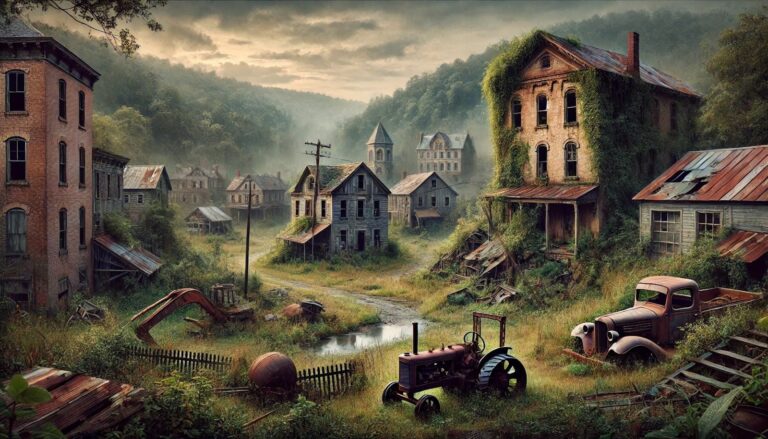Western Kentucky, with its rolling hills, dense forests, and serene lakes, holds many hidden stories beneath its quiet surface. Among the most intriguing of these are the forgotten towns and ghost towns scattered throughout the region. These places, once bustling with life and activity, now stand in various states of decay, offering a glimpse into a past that has largely been erased from modern memory. The term “ghost town” often evokes images of deserted streets and crumbling buildings, but for those who venture into these forgotten corners of the state, they reveal much more—a fascinating narrative of economic booms, industrial shifts, and social changes that reshaped the landscape of Kentucky.
Exploring these abandoned towns provides a unique opportunity to step back in time and connect with a history that is often overlooked. From mining towns that once flourished during the region’s coal boom to riverfront settlements that vanished after railroads bypassed them, these ghost towns are silent witnesses to the ebb and flow of human activity. Though many of these towns are now nothing more than remnants of their former selves, they continue to captivate the imagination of those who seek to uncover their stories. Whether you’re a history buff, a photographer, or simply a curious traveler, the forgotten towns of Western Kentucky offer an unforgettable journey into the past.
Introduction History of Western Kentucky
Western Kentucky has a rich and diverse history, shaped by its geography and role in the broader development of the United States. The region’s fertile soil, abundant rivers, and proximity to major transportation routes made it an attractive area for settlement. In the early 19th century, settlers moved into the area, establishing farming communities and towns along the Ohio and Mississippi Rivers. Agriculture, particularly tobacco and hemp, became the backbone of the economy, and towns grew around these industries. By the mid-1800s, the construction of railroads further connected Western Kentucky to larger trade networks, spurring the growth of towns that were once isolated. The rise of the railroad and river trade transformed the region into a hub of commerce and activity.
Key Historical Developments:
- Early Settlement – Fertile land and river access attracted settlers, leading to the establishment of farming communities.
- Agricultural Economy – Tobacco and hemp became dominant crops, supporting local industries and driving economic growth.
- Railroad Expansion – Mid-1800s railroad construction connected towns to major trade routes, fostering commercial development.
- Industrial and Economic Decline – The mid-20th century saw the decline of coal mining, reduced river traffic due to highway expansion, and changes in agricultural practices, leading to population shifts.
- Ghost Towns and Legacy – Many once-thriving towns were abandoned, leaving behind remnants of Western Kentucky’s prosperous past.
Overview of Western Kentucky’s Forgotten and Ghost Towns
Western Kentucky is home to many forgotten and ghost towns, each with a unique story of rise and fall. These towns, once thriving centers of industry, were founded during economic booms, particularly in the coal and tobacco sectors. However, as industries declined and new transportation routes bypassed them, populations dwindled, leaving once-bustling streets abandoned.
Some towns, like Paducah, began as small river settlements and grew into major hubs, while others were founded as mining or farming communities. Over time, economic shifts led to their decline. Today, some of these towns have disappeared completely, while others still hold traces of their past—decaying buildings, empty storefronts, and abandoned roads. These remnants attract history enthusiasts, urban explorers, and photographers eager to capture glimpses of the past.
| Town Name | Origins | Reason for Decline | Current Status |
| Paducah | River settlement | Industrial shifts, new transport routes | Thriving city, retains historic sites |
| Viola | Farming community | Agricultural decline, urban migration | Small population, some abandoned buildings |
| Golden Pond | Logging and farming | Absorbed into Land Between the Lakes project | Only historical markers remain |
| Between the Rivers | Various small towns | Creation of Land Between the Lakes | Submerged or abandoned |
| Empire | Coal mining town | Coal industry decline | Mostly abandoned |
Each of these towns tells a part of Western Kentucky’s history, from its early economic booms to the shifts that led to their abandonment.
Exploring the Forgotten and Ghost Towns in Western Kentucky
Exploring Western Kentucky’s forgotten and ghost towns offers a journey into the past, revealing the remnants of once-thriving communities. Hidden in rural areas or reclaimed by forests, these towns provide a haunting yet fascinating experience. Visitors can find crumbling buildings, rusted machinery, and abandoned schools and factories, each telling a story of past prosperity and decline. The contrast between decaying structures and nature’s slow takeover adds to the eerie beauty of these locations.
However, exploring these towns comes with challenges. Many sites are difficult to access, requiring navigation through overgrown paths and rugged terrain. Some structures are unstable, making caution essential. Despite these difficulties, the experience is rewarding—offering unique photographic opportunities and a deeper understanding of the region’s history.
Key Aspects of Ghost Town Exploration:
- Abandoned Structures – Ruined homes, factories, and schools stand as silent reminders of the past.
- Natural Reclamation – Forests and vegetation have overtaken many sites, blending history with nature.
- Challenging Access – Many towns require travel on unpaved roads or hiking through dense areas.
- Safety Concerns – Unstable buildings and rugged terrain necessitate caution.
- Photographic Appeal – Decay and history create visually striking scenes.
- Historical Significance – Each town has a unique story of growth, industry, and eventual decline.
For history enthusiasts, photographers, and adventurers, these ghost towns offer a rare glimpse into Kentucky’s forgotten past.
Conclusion
Exploring the forgotten and ghost towns of Western Kentucky is a journey into the past, offering a rare glimpse into the lives of the people who once called these towns home. These abandoned places, now overtaken by nature and time, stand as poignant reminders of the region’s dynamic history—shaped by the rise and fall of industries, economic shifts, and changing transportation routes. For those willing to take the time to explore, these towns hold stories of prosperity, hardship, and transformation, preserved in the decaying remnants of buildings and infrastructure. While they may be quiet now, they continue to capture the imaginations of those who visit, offering an unforgettable experience and a deeper understanding of Kentucky’s heritage.
In conclusion, visiting the ghost towns and forgotten settlements of Western Kentucky is not only about discovering physical remnants of the past, but also about connecting with the stories that shaped the region. These sites, often overlooked by mainstream tourism, provide an opportunity for reflection, preservation, and learning. Whether you are a history enthusiast, a photographer, or simply someone looking to step outside the usual travel destinations, these forgotten towns offer an enriching experience.






